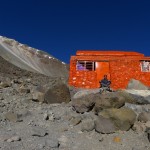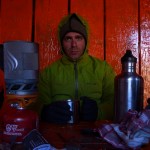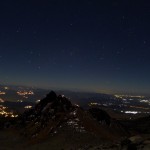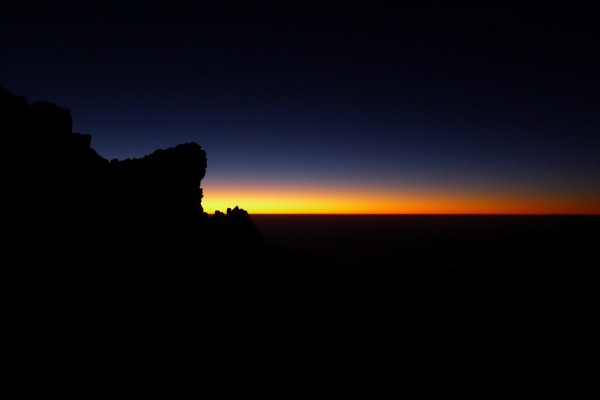Part II: The Climb
5pm:
Climbing Pico de Orizaba (Citlaltepetl) began at the workers hut at 3900m, from which it took me 6 hours to reach the Albergue hut (my high camp) at 4633. I can’t count the amount of times I stopped, removed my overweight pack and just sat there starring off into the misty valleys below. At around 3000m breathing becomes a chore. This effect grows exponentially with every passing 100m. Sometimes I would even stop after taking only 3 steps. By the time I reached the hut I had only the strength to collapse and stare up at the 45 degree slopes of Citlaltepetl.
The path, hut and surrounding area were littered with people’s trash. Like so many other parts of Mexico, the mountain suffers from Mexican’s disregard for nature. People don’t think twice about tossing their soda cans and chip bags out of car windows, or on what could be a pristine path in the mountains – the concept of “leave no trace” has yet to make it south of the border.
11:30pm:
The wind, which brought a deadly chill to the evening had vanished, leaving a starry sky and a rare calm. For a mountain it didn’t even feel particularly cold.
 After lying in the sleeping bag for hours I managed a mere 20 minutes of sleep. Add to that the broken hours of the previous night, and I could count on one hand the amount I have slept going on 3 days. At least the headache, which kept me from sleeping, had gone. Even my breathing felt a little less difficult. But still, I couldn’t sleep.
After lying in the sleeping bag for hours I managed a mere 20 minutes of sleep. Add to that the broken hours of the previous night, and I could count on one hand the amount I have slept going on 3 days. At least the headache, which kept me from sleeping, had gone. Even my breathing felt a little less difficult. But still, I couldn’t sleep.
A group of 5 Mexican climbers came up around midnight. Within minutes they built a fire, and threw some tortillas and potatoes thrown on the first embers. We chatted for a while, talked about the mountain, climbing, Mexico, the filth of the hut… they offered me food and to summit with them later that night. This is just what I wanted – to not climb alone! But they needed to rest first and I couldn’t sleep. I figured I was a slower climber anyway, so I would depart at 1:30am with the hopes they would soon catch up.
1:30am:
It was just light enough that I opted against using my headlamp, and set off to an occasional gentle breeze and the helpful spotlight of the almost full moon which lit up the mountain.
Pale silvery glow of the rocks; hard shadows thrown from every minuscule pebble; shadows from larger boulders leaving in obscurity great swaths of path.
3:00am:
Based on my observations from 4600m, I determined what looked like to be the right path: a quick north-westerly traverse of a small boulder field to a rocky ridge leading up to the summit pyramid. The south side was nothing but a giant sand/dust and scree field – impossible to climb. The only options were the ridges and their relatively more stable ground, so I chose the one to the west – the closest to camp. The final approach on the south is entirely a scree field, but I would deal with that later. There was no snow or ice anywhere to help me. Whatever accumulation from a 3 day dump the previous week, was all gone.
As usual my going was slow, but it was not only the lack of oxygen which made me stop often to look around.
Directly south of Pico de Orizaba is another volcano, with an observatory at the top. To each side the valley is revealed and framed by two southern ridges of Pico. The stars in a cloudless sky, and the lights of the tiny pueblos, sparkled above and below. Hills to the far side of the valley retreated gradually into the ever-present mist. At that moment the whole world felt tranquil. I wanted less to go to the peak, than to remain in that contemplative calm.
Every step higher, as I rose above the ridge lines, revealed more and more of the valley. With every new twinkling pueblo I felt the warmth of a hearth and the comfort of a home. That it was 3a.m and I was alone on a vast and cold mountain, made no difference. Lights were on in the tiny clusters of civilization, which, by some miracle, remained in the fertile valley of Mexico’s section of the Pacific Ring of Fire. Conquest and disease, corruption and drug wars, French and American invaders, a dozen active volcanoes… all failed in displacing and snuffing out the lights below.
Sadly, what mountains are best for – contemplation, is not something they allow. No matter how fine the weather, more than 5 minutes of inactivity is the catalyst for a state of cold which is hard to get rid of.
I remember the views from every peak on which I have stood in the last 16 years. I also remember that every time I wanted to remain, to contemplate the great vastness, the insignificance of our hubris, the glorious testament to time and patience before me, I was always run off by the setting sun, 80mph winds, impeding frost bite, threatening cold or rain. As a matter of fact, in the last 16 years I have never spent more than 20 minutes at the summit of a mountain.
But only today did I realize that no matter the splendor of that view from the roof of the world – above clouds and pettiness – it is the presence in the mountains, whether in a valley or on a ridge, which is most gratifying. It is there, around, as opposed to on top the mountain, which lends one more time to observe and contemplate and listen to the great secrets which long ago every person knew.
And though I realized this, and with ever growing weakness from hunger, sleep deprivation, lack of oxygen and thirst, I still kept moving forward and higher.
But with every step my head grew more faint, my stomach more uneasy. As the water in my camel pack froze and wind began to pick up, every step became harder, and every time I would stop I nearly fell asleep on my feet. With the dehydration and increased altitude the headache returned to add to my joy. I began to feel dizzy and to stumble on the uneven and constantly changing path. What I thought would be a steadier climb turned out to be an alternating field of sand, scree and boulder. But in the moonlight I could not have known that traversing along the east side of the ridge would have allowed for a more constant, and therefore easier, assent.
Why, oh why did I not go to the north side where there is snow and ice and climbing makes more sense? The problem with sand and scree is that so often you need to take 2-3 steps in order to move forward 1. The constant sliding back and near rock slides which are avoided by draining spurts of energy, are the inglorious end to many a summit bid. For every 10 second burst of energy I needed a 4 minute rest. My fingers and toes grew more numb, and because I was not moving fast or continually enough, my body temperature kept falling.
5:30a.m:
I have now stopped and urged myself to turn around a hundred times. But after shacking myself from sleep and looking up to see how close the summit seemed to be, I would again venture a few steps. A few steps closer, a few steps higher, and the cycle repeats. I wished the sun would rise already and chase away the ominous shadows, but it remained bleak and dark and cold.
An agonizing hour later the grayness of the east began to take on a reddish hue. Finally the light is come! I stood gazing at the peak above and at the valley below. What splendor am I about to witness with the rising sun! I turned again toward the peak, took two steps, and in a moment realized I am still alone – the other climbers had not even started yet. My vision blurry, my head swimming, my water inaccessible; if I collapse and hit my head on a rock… I am alone. Even if the sun lights for me a golden path, that path would still take me through unstable ground at 30-45 degree angles. And if now I barely take 3 steps before almost falling from weakness…
With the summit so close I could taste it, I took out my GPS, marked my elevation at 5200m (my personal record), turned around and headed back to the hut.
Either as a consolation, or mocking, the sun rise was resplendent. I did not waste the opportunity to stop and gaze for as long as the wind would allow me.
As I approached the hut at 7:30a.m, the 5 Mexican climbers met me on the trail a few hundred paces from the hut. I told them about the trail, wished them luck, stumbled into the hut, made a cup of instant soup and passed out.
